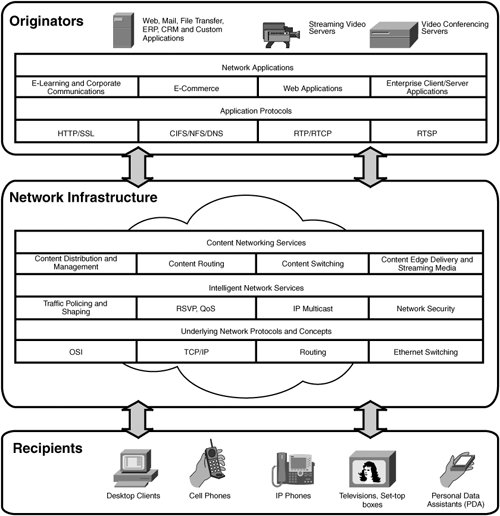Defining Content Networking
| Content networking involves elements from all aspects of network computing, from high-level applications to underlying network protocols. Understanding of the basics of both computer networking and applications developed for networks is a crucial prerequisite to obtaining a deeper understanding of content networking. Thus, this book covers the following three network entities to help you better understand this wide-reaching field:
Figure 1-1 illustrates the relationships among these three entities. Related content networking concepts highlighted in the Figure 1-1 will be discussed in detail throughout this book. Figure 1-1. Relationship Between Recipient, Network, and Originator Content Network Entities In the past few decades, TCP/IP has become the most common networking protocol, and its original intention has remained as valid today as when it was conceived in the late 1960s. That is, it remains a simple method to deliver a payload from one location to another. Indeed, in the recent past, the only service the network provided to an application was packet delivery, with either guaranteed or best-effort service levels. Moreover, clients were aware of only a few basic details concerning the origin server, such as name and services provided. The originators were completely unaware of details about their requesting clients, except those anticipated and hard-coded into the application by its developer. Neither knew much more about the network on which content was delivered and received than how to interface into it. Until recently, the function of the network remained separate from the applications that ran on it. In the past few years, acknowledging the new and increasing demands for the network to add value to applications, the Cisco development team has pushed its networking software toward implementing content networking technologies. Slowly, existing network devices were extended with a few of the application protocols and intelligent network services shown in Figure 1-1. Eventually, however, a vast new suite of content-based products was created, resulting in the robust content networking solutions that exist today. As you will see throughout this book, content networking provides numerous services to accelerate content delivery and encompasses all aspects and protocols included within the three entities shown in Figure 1-1. Content networking is a new paradigm of computing and communications. Concentration has shifted from both computers and networks, individually, toward the creation of a collective system called a content network, encompassing characteristics of both computers and networks. Thus, content networking can be broadly defined as content-awareness by not only the originator of the content but by all three basic network entities. As you may find, however, content networking is somewhat vague when defined generally. In the remainder of this Chapter, you explore a more detailed definition of content networking in terms of the following three specific categories:
|
EAN: 2147483647
Pages: 178